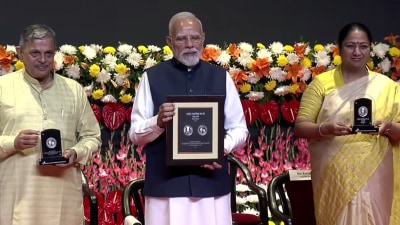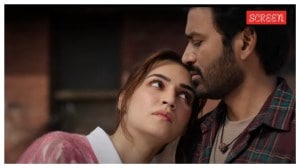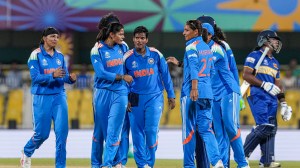This is a happy new world
Last fortnight, soon after Indian troops and the Air Force launched their strikes in Kargil reports began to appear on various television...

Last fortnight, soon after Indian troops and the Air Force launched their strikes in Kargil reports began to appear on various television channels. A foreign network got a reaction from the Pakistani foreign minister. Sartaj Aziz, looking cheerfully unruffled, as if he had been caught in the midst of a pressing enga-gement, was critical of India’s action and claimed to be ready to take whatever action if any were required in his country’s defense.
What about the hundreds of armed intruders that India was claiming as its own very serious provocation for the air strike? He didn’t say. What was one to make of this? That there were no intruders? That Pakistan had nothing to do with them? That the situation did not warrant India’s response? It is common of course in such cases for confronting nations to take contradictory stands. But to take no stand at all? But then perhaps one should not be surprised. For increasingly we have learnt to live with ambiguity.
Not the ambiguity that arises naturally from thecomplex interaction of circumstances but a deliberately created or permitted fuzziness. Truth is relative. Truth is subjective. And now truth is a ping pong ball. For some time now we have watched the BJP and its pro-Hindutva allies keep it up in the air with their expert use of doublespeak : the demolition of the Babri masjid was `a misadventure’, `a natural reaction’; the murder of an Australian missionary demands `investigation’, `a national debate on conversions’. More recently we have witnessed Sonia Gandhi and her strategy of no speak: Madam has not expressed her desire to be prime minister but madam has not said no to being prime minister either.
It is not just in politics where we find such practised jugglery. If you will, check out the latest issue of Stardust. The magazine has stories on three purported liaisons – the very stuff of a VFM gossip magazine. The stories come with glossy pictures of the alleged lovers – eyes locked, dreamy glances, shared laughter, cosy embraces. Picturesobtained by stealth? No way.
The concerned couples came willingly into the studio and posed before settling down to say: "Friendship is more like it today", "We’re best friends", "We’re not going around really". Really?
In the old days when circumstances were more restricting one expected such denials from amorous stars. What one also expected was a thorough investigation from the editorial staff. Reports of intimate dinners, visits to make-up rooms, stakeouts on location, interviews with indiscreet co-stars and hairdressers, nosy hotel managers, producers and eagle-eyed spot boys.
In short, clinching evidence one way or another. Today what we get instead is the giggly triumphant laughter of those who didn’t take a stand and still cashed in on the photo op.
More of that laughter is slated to come our way in the near future. As campaigning gets underway for the coming elections and politicians, safe in the knowledge that you can smile, smile and still fudge the truth will vie for our attention withbright clothes and dental floss. They will speak in many voices. They will deny, contradict, admit, retract. Members of the same party will express varying views and still claim to agree. They will identify an issue as being central to their campaign then distance themselves from it. So on and so forth.
As for us we will sink into deeper and deeper confusion. For that — apart from many others — is the consequence of such maybe-maybe-not opportunism. It is a process in which facts get blurred. Since nothing is committed to, everything is possible. And the truth from being something fixed and determinable becomes a shifting, constantly malleable commodity. And reality takes on a bad soap opera like quality where everything is uncertain and nothing gets resolved. Taylor is dead. Ridge and Brooke are getting married. Happiness is finally theirs. But no, Taylor is alive!
Why have we allowed ourselves to fall into this state of nervous apprehension? Why are we willing hostages to an environment of vaguetruths, befuddlement and doubt? The answer has partly to do with trends in the media – the excessive dependence on the straight interview and the overwhelming emphasis on the visual. But beyond that, contradictory as it sounds, it has much to do with our own demand for guaranteed happiness. Doubt and guarantee. How does that work?
Simple. When options close, some sacrifice is made, some pain inflicted. When every option is open, everything is possible. For an example look no further than the recent blockbuster Kuch Kuch Hota Hain. Here you had a situation. Two women love one man (Shahrukh Khan). The man loves one.
Someone had to get hurt, right? Wrong. Since romantic compulsions required a choice the man got to love them both serially with the first wife (Rani Mukherjee) cheerfully dying to make way for the second (Kajol). And just about everybody (including the jilted fiance and the dead wife smiling from the skies) was happy. And that’s not all. According to a Bollywood scriptwriter, a popularnotion among teenage fans was that KKHH was actually a continuation of an earlier blockbuster Dil To Pagal Hain.
In DTPH Shahrukh Khan (again) was loved by Madhuri and Karishma Kapoor. He chose Madhuri. But, put the two films together and you have Madhuri turning into Rani Mukherjee who dies with cheerful alacrity to hand him over to Kajol who is actually Karishma Kapoor. And this time everybody is really happy. La la land? Or welcome to the new world: No pain all gain.



- 01
- 02
- 03
- 04
- 05




























